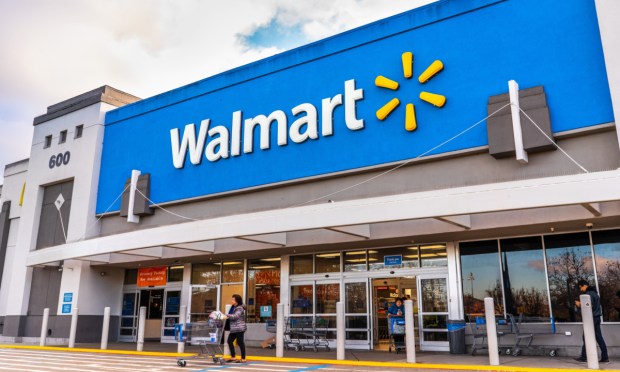
Walmart has made the consumer spending slowdown official.
As fiscal year third-quarter earnings results debuted Thursday morning (Nov. 16) showed a cautious outlook on consumers’ willingness to open their wallets into the holiday shopping season after the quarter’s end, investors sent the shares tumbling more than 7%.
Chief Financial Officer John D. Rainey noted during a conference call with analysts that, “recently, we’ve experienced a higher degree of variability in weekly performance in between holiday events in the U.S., including seeing a softening in the back half of October. It was off trend to the rest of the quarter.”
And, he added, “sales have been somewhat uneven, and this gives us reason to think slightly more cautiously about the consumer versus 90 days ago.”
Sales growth will moderate, according to management projections, as grocery inflation normalizes, and traffic looks set to increase to the stores themselves.
Management’s caution has overshadowed some of the trends that continued unabated through the most recent quarter — namely, enthusiasm on the part of consumers for omnichannel options bridging digital and brick-and-mortar operations.
Company materials revealed that in the United States, comp sales grew by 4.9% with strength in grocery and health and wellness categories. That strength, Walmart revealed, was partially offset by softness in general merchandise. eCommerce sales surged by 24%, where the double-digit growth was led by in-store-fulfilled pickup and delivery, and by what the company said was a 26% leap in Walmart Connect, the platform enabling advertisers to reach customers online and in stores.
Each of Walmart’s three operating segments experienced mid-single-digit sales growth, with comp sales for Walmart U.S. up 4.9% and Sam’s Club U.S. up 3.8%.
Grocery sales were up mid-single-digit percentage points, health and wellness was up in the high teens as a category, and general merchandise declined by low-single-digit percentage points.
CEO Doug McMillion said during the call that the shift to eCommerce channels has been underscored by fiscal 2024’s third quarter.
In addition to the 24% gains seen with Walmart’s U.S. operations, eCommerce sales surged 16% for Sam’s Club and were up 15% globally.
While consumer spending is uneven at best, inflation continues to have an impact. McMillon said that “pricing levels in many food categories continue to be a concern overall. Our product costs are up versus last year, and they remain up even more on a two-year stack, which is putting pressure on our customers.”
There are “pockets of disinflation” that are in place, he said, but the firm would like to see more of that trend take root, “especially in the dry grocery and consumables categories.”
Management commentary on the call noted that grocery inflation moderated 3% from the second quarter but on a two-year stack, in Rainey’s words, “it was still elevated at a high-teens percentage.”
The company’s third-party marketplace continues to show momentum, said McMillion, who added that “the marketplace is one of our engines for … mutually reinforcing businesses, meaning that marketplace growth pulls other businesses like fulfillment through” the company’s results. Since the beginning of last year, he said, Walmart has more than doubled the number of items available to customers on its U.S. marketplace.
The company opened its third “next-generation” eCommerce fulfillment center, with Rainey observing that the 1.5 million-square-foot facilities are expected to more than double the storage capacity and enable twice the number of customer orders fulfilled daily. He said the firm “will expand next- and two-day shipping to nearly 90% of the U.S., including marketplace items shipped by Walmart fulfillment services.”
Said Rainey later during the call: “Over the past year, Walmart U.S. has increased the percentage of digital orders fulfilled by stores by 800 basis points [8%], and Sam’s Club fulfills nearly 60% of online orders from its clubs.”
McMillion added: “…the marketplace over time, of course, will be a key driver to some of the other businesses like advertising. As more sellers find customers on the Walmart marketplace, they’ll want to use services like our fulfillment services and our advertising business.”
Beyond the U.S., Rainey said, the growth rate for PhonePe operations, based in India, showed an annualized total payments volume of $1.2 trillion tied to 1.2 trillion transactions, with roughly 500 million users.
Asked on the call about the state of the consumer, Rainey said that “we’re seeing credit tightening … 12 months after the Fed began raising rates, we’ve seen consumer balance sheets that are getting back close to pre-pandemic levels. You’ve got the repayment of student loans, which affects about 27 million Americans. All of these things could be contributing … so that’s why we take a little bit more of a cautious stance as we go into the fourth quarter.”
For all PYMNTS retail coverage, subscribe to the daily Retail Newsletter.